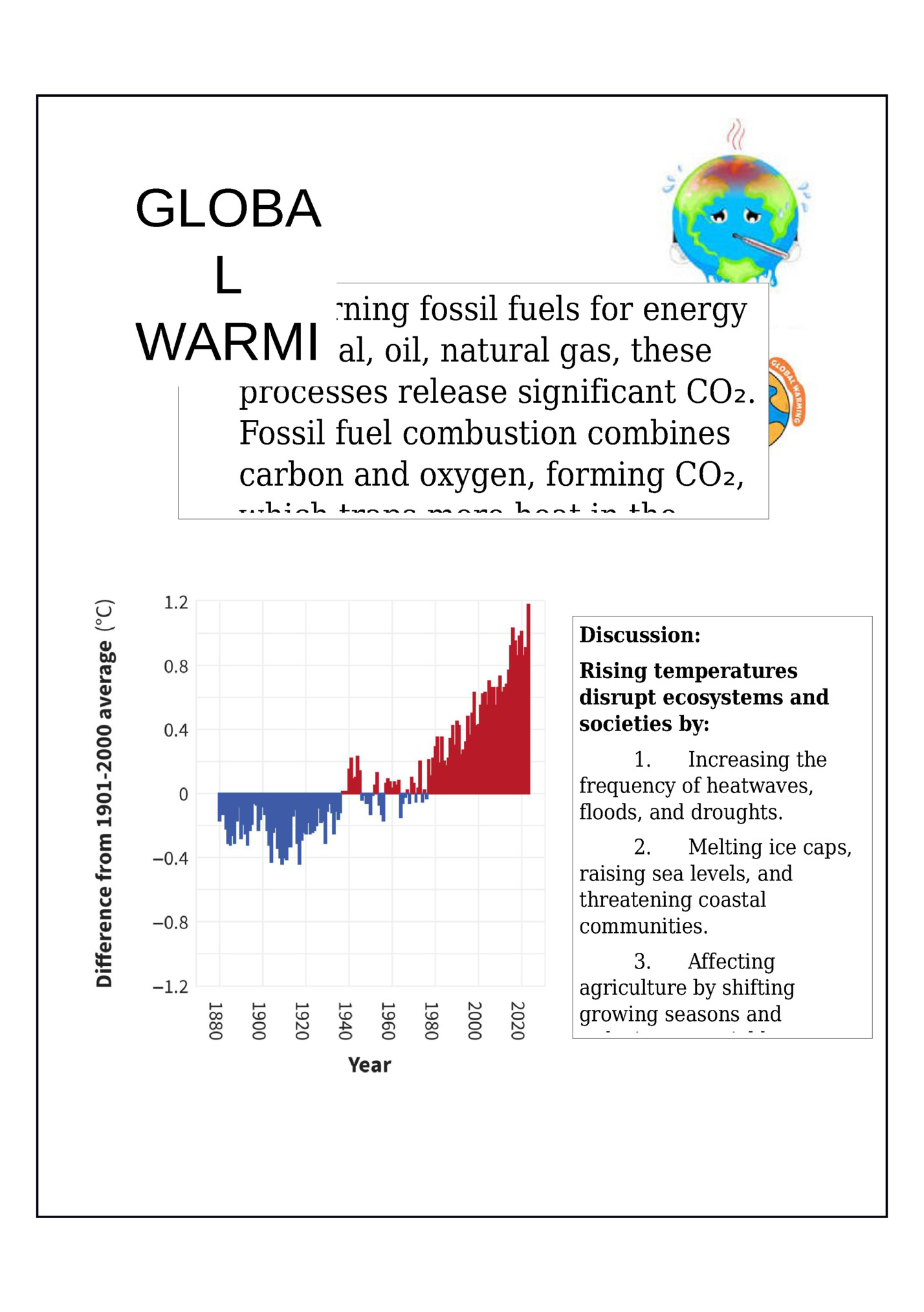Crisis SOPHIE MATHIAS 3 SCIENCE 22/11/24

OF Fundamentals of Greenhouse CONTE Gases…………………. Page 1 NTS Global

Greenhouse Effect Greenhouse gases trap heat in the atmosphere by absorbing infrared radiation emitted from Earth’s surface and re-radiating it. This process prevents heat from escaping into space, maintaining a stable climate necessary for life.

GHGs and Sources: 1. Water Vapor (H₂O): Natural evaporation. 2. Carbon Dioxide (CO₂): Natural (volcanic activity) and human-made (burning fossil fuels). 3. Methane (CH₄): Natural (wetlands) and human-made (livestock, agriculture). Reflection: The greenhouse effect is vital for keeping Earth warm enough for life by trapping heat in the atmosphere. However, human activities like burning fuels and cutting trees add too many greenhouse gases, making the planet dangerously hotter. This disrupts weather, melts ice, and harms ecosystems. While the natural effect is good, too much of it creates instability. 4. Nitrous Oxide (N₂O): Natural (soils) and humanmade (fertilizers)

LBy Burning fossil fuels for energy WARMI oil, natural gas, these like coal, processes release significant CO₂. NG fuel combustion combines Fossil - carbon and oxygen, forming CO₂, which traps more heat in the Discussion: Rising temperatures disrupt ecosystems and societies by: 1. Increasing the frequency of heatwaves, floods, and droughts. 2. Melting ice caps, raising sea levels, and threatening coastal communities. 3. Affecting agriculture by shifting growing seasons and reducing crop yields

- Climate change refers to long-term shifts in temperature and weather patterns, while global warming specifically focuses on the rise in Earth’s average temperature due to human activities, such as the burning of fossil fuels. While global warming is a key driver of climate change, climate change includes a broader range of changes, including altered precipitation patterns, rising sea levels, and shifting ecosystems. Consequences of Climate Change: 1. Increased Sea Temperatures: Rising ocean temperatures threaten coral reefs, such as Belize’s barrier reef, which is essential for marine biodiversity and local livelihoods. Warmer waters lead to coral bleaching, which damages the reefs and reduces the abundance of marine life. 2. Intensified Storms: The frequency and intensity of hurricanes have increased, leading to more severe damage from storms like those that hit Belize in recent years. These storms disrupt local economies and cause widespread destruction. 3. Impact on Agriculture: Climate change is altering rainfall patterns, leading to droughts in some areas and floods in others, which directly affects food production. This variability impacts Belize’s agricultural sector, crucial for both domestic consumption and export. Impact on Biodiversity: The Endangered Belizean Coral Reefs are particularly at risk due to climate change. As sea temperatures rise, coral reefs experience bleaching, where corals lose the algae they rely on for nutrition. This not only affects marine biodiversity but also the economy of Belize, as tourism and fishing are heavily dependent on these ecosystems. Local Connection: In Belize, climate change has resulted in rising sea levels, affecting coastal areas and coral reefs. Changes in precipitation patterns have also disrupted farming practices, with both floods and droughts affecting crop yields. Additionally, extreme weather events, such as stronger hurricanes, pose a growing threat to infrastructure and local communities.

Action Plan: 1. Use Energy-efficient Appliances: Switch to energy-saving devices and turn off lights when not in use. 2. emissions. 3. Sustainable Transportation: Opt for public transport, cycling, or walking to reduce car Plant Trees: Trees absorb CO₂, helping offset emissions. Alternative Energy: • Solar Energy: Solar power reduces CO₂ emissions by using renewable energy from the sun, cutting reliance on fossil fuels. Your Role: Pledge: I will use my bike for short trips instead of driving for the next month to reduce my carbon footprint.

- The greenhouse effect naturally keeps Earth warm enough to support life, but human activities, like burning fossil fuels and deforestation, have intensified this effect, leading to global warming. Global warming is the rise in Earth’s temperature, while climate change includes broader shifts in weather patterns, rising sea levels, and ecosystem disruptions. These changes cause extreme weather events, harm biodiversity, and affect human societies. Immediate action is required to reduce greenhouse gas emissions and mitigate the impacts of climate change. Call to Action: Slogan: “Protect Our Planet, Preserve Our Future!”

ENCES 1. NASA Climate Kids: https://climatekids.nasa.gov • National Geographic: https://www.nationalgeographic.com/environment • EPA (Environmental Protection Agency): https://www.epa.gov/ghgemissions 2. Exploring Global Warming • Intergovernmental Panel on Climate Change (IPCC): https://www.ipcc.ch

Fleepit Digital © 2021